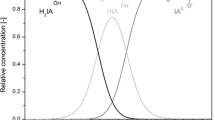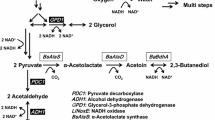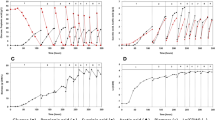Abstract
A cell-retention fermenter was used for the pilot-scale production of kojic acid using an improved strain of Aspergillus oryzae in repeated-batch fermentations. Among the various carbon and nitrogen sources used, sucrose and yeast extract promoted pellet morphology of fungi and higher kojic acid production. Repeated-batch culture using a medium replacement ratio of 75% gave a productivity of 5.3 g L−1 day−1 after 11.5 days of cultivation. While batch culture in shake-flasks resulted in a productivity of 5.1 g L−1 day−1, a productivity of 5 g L−1 day−1 was obtained in a pilot-scale fermenter. By converting the batch culture into repeated batches, the non-productive downtime of cleaning, filling and sterilizing the fermenter between each batch were eliminated, thereby increasing the kojic acid productivity.







Similar content being viewed by others
References
Ariff AB, Rosfarizan M, Herng LS, Madihah S, Karim MIA (1997) Kinetics and modelling of kojic acid production by Aspergillus flavus Link in batch fermentation and resuspended mycelial system. World J Microbiol Biotechnol 13:195–201
Bajpai P, Agrawala PK, Vishwanathan L (1982) Production of kojic acid by resuspended mycelia of Aspergillus flavus. Can J Microbiol 28:1340–1346
Bentley R (1957) Preparation and analysis of kojic acid. Methods Enzymol 3:238–241
Du LX, Jia SJ, Lu FP (2003) Morphological changes of Rhizopus chinesis 12 in submerged culture and its relationship with antibiotic production. Process Biochem 38:1643–1646
Futamura T, Ishihara H, Tamura T, Yasutake T, Huang GW, Kojima M, Okabe M (2001) Kojic acid production in an airlift bioreactor using partially hydrolyzed raw corn starch. J Biosci Bioeng 92:360–365
Futamura T, Okabe M, Tamura T, Toda K, Matsunobu T, Park YS (2001) Improvement of production of kojic acid by a mutant strain Aspergillus oryzae, MK107-39. J Biosci Bioeng 91:272–276
Kwak MY, Rhee JS (1992) Controlled mycelial growth for kojic acid production using Ca-alginate-immobilized fungal cells. Appl Microbiol Biotechnol 36:578–583
Kwak MY, Rhee JS (1992) Cultivation characteristics of immobilized Aspergillus oryzae for kojic acid production. Biotechnol Bioeng 39:903–906
Majmudar G, Jacob G, Laboy Y, Fisher L (1998) An in vitro method for screening skin-whitening products. J Cosmet Sci 49:361–367
Meletiadis J, Meis JF, Mouton JW, Verweij PE (2001) Analysis of growth characteristics of filamentous fungi in different nutrient media. J Clin Microbiol 39:478–484
Ogawa A, Wakisaka Y, Tanaka T, Sakiyama T, Nakanishi K (1995) Production of kojic acid by membrane-surface liquid culture of Aspergillus oryzae NRRL 484. J Ferment Bioeng 80:41–45
Ozturk G, Erol DD, Aytemir MD, Uzbay T (2002) New analgesic and antiinflammatory agents 4(1H)-pyridinone derivatives. Eur J Med Chem 37:829–834
Papagianni M (2004) Fungal morphology and metabolite production in submerged mycelial processes. Biotechnol Adv 22:189–259
Pedersen AG, Bundgaard-Nielsen M, Nielsen J, Villadsen J, Hassager O (1993) Rheological characterization of media containing Penicillium chrysogenum. Biotechnol Bioeng 41:162
Rosfarizan M, Ariff AB (2000) Kinetics of kojic acid fermentation by Aspergillus flavus using different types and concentrations of carbon and nitrogen sources. J Ind Microbiol Biotechnol 25:20–24
Rosfarizan M, Ariff AB, Hassan MA, Karim MIA, Shimizu H, Shioya S (2002) Importance of carbon source feeding and pH control strategies for maximum kojic acid production from sago starch by Aspergillus flavus. J Biosci Bioeng 94:99–105
Tomita I, Mitsuhashi K, Endo T (1996) Synthesis and radical polymerization of styrene derivative bearing kojic acid moieties. J Polym Sci A 34:271–276
Uher M, Konecny V, Rajniakova O (1994) Synthesis of 5-hydroxy-2-hydroxymethyl-4H-pyran-4-one derivatives with pesticide activity. Chem Pap 48:282–284
Wakisaka Y, Segawa T, Imamura K, Sakiyama T, Nakanishi K (1998) Development of a cylindrical apparatus for membrane-surface liquid culture and production of kojic acid using Aspergillus oryzae NRRL484. J Ferment Bioeng 85:488–494
Wan HM, Chen CC, Chang TS, Giridhar RN, Wu WT (2004) Combing induced mutation and protoplasting for strain improvement of Aspergillus oryzae for kojic acid production. Biotechnol Lett 26:1163–1166
Author information
Authors and Affiliations
Corresponding author
Rights and permissions
About this article
Cite this article
Wan, H.M., Chen, C.C., Giridhar, R. et al. Repeated-batch production of kojic acid in a cell-retention fermenter using Aspergillus oryzae M3B9. J IND MICROBIOL BIOTECHNOL 32, 227–233 (2005). https://doi.org/10.1007/s10295-005-0230-5
Received:
Accepted:
Published:
Issue Date:
DOI: https://doi.org/10.1007/s10295-005-0230-5




